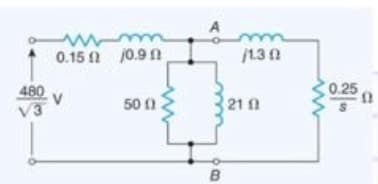For the system in the diagram: 1. The line current at startup. Use this per-phase equivalent circuit: Apply Ohm's law, note that slip is equal to 1 at startup and the resulting current is complex. Show the current in polar form. 2. The starting torque. For each phase, Tstart = Pin/ധs , and the input power is the "line current squared times the equivalent rotor resistance given as 0.25/slip with slip = 1 at startup." 3. Find the full-load current with a star starter and the power factor. Use Ifl = VL/Zeq, VL from the above circuit, and Zeq must include the slip calculated in problem 4. Show the complex current in polar form 4. Determine the full-load torque. The suitable formula for the full-load torque is derived as: Tfl = (per phase x 3) Ifl2 x Req / (ധs x slip). Req is the sum of all the resistive impedances from the above circuit. Get the synchronous speed, and slip from problem 4. Note: From Problem 4: Synchronous Speed Ns = 1800 rpm Slip s = 2.5%
Load flow analysis
Load flow analysis is a study or numerical calculation of the power flow of power in steady-state conditions in any electrical system. It is used to determine the flow of power (real and reactive), voltage, or current in a system under any load conditions.
Nodal Matrix
The nodal matrix or simply known as admittance matrix, generally in engineering term it is called Y Matrix or Y bus, since it involve matrices so it is also referred as a n into n order matrix that represents a power system with n number of buses. It shows the buses' nodal admittance in a power system. The Y matrix is rather sparse in actual systems with thousands of buses. In the power system the transmission cables connect each bus to only a few other buses. Also the important data that one needs for have a power flow study is the Y Matrix.
Types of Buses
A bus is a type of system of communication that transfers data between the components inside a computer or between two or more computers. With multiple hardware connections, the earlier buses were parallel electrical wires but the term "bus" is now used for any type of physical arrangement which provides the same type of logical functions similar to the parallel electrical bus. Both parallel and bit connections are used by modern buses. They can be wired either electrical parallel or daisy chain topology or are connected by hubs which are switched same as in the case of Universal Serial Bus or USB.
For the system in the diagram:
1. The line current at startup. Use this per-phase equivalent circuit:
Apply Ohm's law, note that slip is equal to 1 at startup and the resulting current is complex. Show the current in polar form.
2. The starting torque. For each phase, Tstart = Pin/ധs , and the input power is the "line current squared times the equivalent rotor resistance given as 0.25/slip with slip = 1 at startup."
3. Find the full-load current with a star starter and the power factor. Use Ifl = VL/Zeq, VL from the above circuit, and Zeq must include the slip calculated in problem 4. Show the complex current in polar form
4. Determine the full-load torque. The suitable formula for the full-load torque is derived as:
Tfl = (per phase x 3) Ifl2 x Req / (ധs x slip). Req is the sum of all the resistive impedances from the above circuit. Get the synchronous speed, and slip from problem 4.
Note: From Problem 4:
Synchronous Speed Ns = 1800 rpm
Slip s = 2.5%

Step by step
Solved in 5 steps with 31 images









